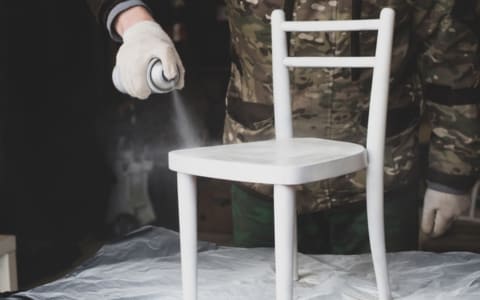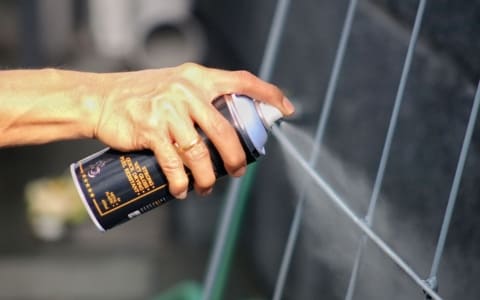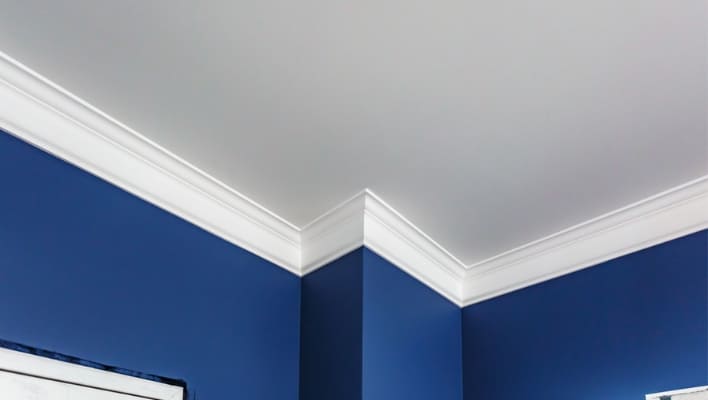Spray painting can be a convenient way to give surfaces a fresh and even coat of color. Sometimes, you might want to change or make the existing painted surface better. The question that often arises is, can you paint over spray paint? In this helpful guide, we’ll go through the steps to make sure you understand everything easily.

Table of Contents
- Can I paint on spray paint-Quick Summary
- What paint can I use over spray paint?
- Can you paint enamel over spray paint?
- Can you paint acrylic over enamel spray paint?
- Can I Put Latex Paint Over Spray Paint?
- Can You Paint Over Rust-Oleum Spray Paint?
- Can You Paint Over Gloss Spray Paint?
- Can You Brush Paint Over Spray Paint?
- Why Paint Over Spray Paint?
- Can You Paint Over Spray Paint Primer?
- What paint sticks to spray paint?
- How to Paint over Spray Paint?
- Surface Prep:
- Sanding for Better Adhesion
- Choosing the Right Primer
- Applying the Primer
- Choosing Appropriate Paint Type
- Applying Thin and Even Coats
- Finishing Touches for Flawless Results
- Final Words On Can you paint over spray paint :
- Rosalie Sanchez
Can I paint on spray paint-Quick Summary
Yes, painting over spray paint is a great way possible to revitalize old items. Make sure that the painted surface is not only dry but also hasn’t been painted recently for the best results. After that, cover the work area, sand the surface to remove the old finish, apply a primer for better adhesion, and then start painting.
What paint can I use over spray paint?
When thinking about painting over spray paint, prep the surface thoroughly. Once the spray paint is fully dry and cured, you have the flexibility to choose from different types of paint. Here’s a breakdown of the options:
- Acrylic Paint: This versatile choice generally adheres well to spray paint. Start with a clean surface, and consider using a primer for good result.
- Latex Paint: Similar to acrylic, latex paint, being water-based, can be applied over spray paint. Make sure the spray paint is firmly adhered, and for added durability, think about using a bonding primer.
- Enamel Paint: Enamel paint, which is oil-based, can be used over spray paint, but it’s important that the spray paint is fully cured and the surface preparation is properly done before painting.
Remember, regardless of the paint type you choose, cleaning the surface and lightly sanding it can significantly enhance adhesion
Can you paint enamel over spray paint?
If the spray paint you’re working with is water-based, it’s possible to apply enamel over it, but it’s crucial to ensure the existing paint job is intact and hasn’t been sealed. Using a primer before applying enamel paint is a smart move for long-lasting results.
In the case of oil-based spray paint, you can directly apply oil-based enamel without the need for a primer. Begin by cleaning the surface with soapy water and letting it dry completely. Subsequently, sand the surface to eliminate imperfections and create a smooth base for the enamel paint. This step is particularly beneficial for high-gloss spray paints. Once the surface is adequately smooth, it’s prepared for the application of new paint.
To avoid any color discrepancies, it’s advisable to choose an enamel that matches the color of the spray paint or opt for a darker shade.
Can you paint acrylic over enamel spray paint?

I have observed few things while painting acrylic over enamel paint. Ensure the enamel paint is dry. Clean the surface, sand lightly, and wipe off dust. Use oil-based primer over enamel, let it dry, and apply acrylic paint in thin coats, allowing each to dry. Follow paint can instructions for best results.
Can I Put Latex Paint Over Spray Paint?
When considering painting over spray paint with latex paint, it’s generally feasible, particularly on surfaces like wood or drywall. However, for optimal results, pay attention to the type of spray paint used. If it has a high-gloss finish, applying a primer before the latex paint can enhance adhesion and color coverage.
Before proceeding, ensure that the spray paint is fully dry, clean the surface to remove any impurities, and lightly sand to create a textured surface for better adhesion. Choosing a primer compatible with both spray and latex paint is crucial in this process. Once the primer has dried, you can confidently proceed with applying the latex paint, resulting in a smooth and successful finish. This approach ensures that the new coat adheres well and provides the desired aesthetic outcome.
Can You Paint Over Rust-Oleum Spray Paint?
For a successful paint job over Rust-Oleum, it’s important to ensure the surface is in good condition with no loose or flaking paint.
When it comes to painting over Rust-Oleum, using an oil-based paint is a suitable choice. Many Rust-Oleum spray paints are oil-based, making them compatible with other oil-based paints. Oil-based paints adhere well to Rust-Oleum surfaces. Ensure the Rust-Oleum coat is clean, dry, and lightly sanded before applying oil-based paint.
Can You Paint Over Gloss Spray Paint?
You can apply a new coat of paint over glossy spray paint, but it’s crucial to undertake proper preparation to ensure a durable and visually appealing finish. While the concept of painting over gloss is feasible, it’s not advisable without adequate surface preparation.
The glossy surface of the spray paint may hinder adhesion for the new layer of paint, potentially leading to issues like chipping and an uneven appearance over time. To address this, it’s recommended to sand the glossy surface lightly, using fine-grit sandpaper (around 220-grit). This process doesn’t aim to remove the glossy layer entirely but rather to create a slightly textured surface, enhancing the adherence of the new paint.
Priming the surface is another crucial step in this process. Choose a primer specifically designed for glossy surfaces, as it promotes better adhesion and contributes to a smoother finish for the subsequent paint layers. Allow the primer to dry thoroughly. Learn more about painting eggshell over semi gloss paint.
Selecting the right type of paint for the material you are working on is equally important. Check if the paint works for wood, metal, or plastic. Put on thin, even coats, and let each dry before adding more. This stops drips and makes the finish look good.
Latex or acrylic paints are also viable for Rust-Oleum surfaces if properly prepared. Prioritize cleaning, light sanding, and the application of a suitable primer before using latex paint to achieve optimal results.
Enamel paints, available in both oil-based and water-based variants, are effective for Rust-Oleum. Ensure the surface is clean and lightly sanded to enhance adhesion, contributing to a durable and aesthetically pleasing finish.
Can You Brush Paint Over Spray Paint?

Yes, you can use brush paint over spray paint, but it’s essential to wait for the spray paint to thoroughly dry and cure. Prior to applying the new paint with a brush, make sure the surface is clean and free from any dust or debris
Choose a good-quality brush that matches the type of paint you’re using. Apply the brush strokes evenly, following the guidelines provided by the paint manufacturer. This technique is ideal for touch-ups or incorporating finer details into your project.
Why Paint Over Spray Paint?
Painting over spray paint is a common way to change an object’s color or give it a fresh appearance. It also helps cover any previous imperfections or unevenness from the old spray paint. The process involves cleaning, light sanding, using a suitable primer for better adhesion, choosing quality paint compatible with the surface, and applying thin coats with ample drying time between them. This ensures a smooth and durable finish.
When using spray paint as a base coat, you benefit from a quick application, especially for larger pieces or canvases, making it more convenient than using a brush. Using a thinner spray paint base has the advantage of quicker drying, enabling you to complete your project on time. Additionally, opting for less paint during base coats can lead to long-term cost savings.
Can You Paint Over Spray Paint Primer?
Yes, you can paint over a dry spray paint primer. In the case of water-based primers, compatibility exists with various paint types. For oil-based primers, stick to oil-based paint. Many spray paints are oil-based. Make sure your paints match for the best results. It’s advised to lightly sand the primer before the topcoat for better adhesion and a smoother finish.
What paint sticks to spray paint?
When considering painting over spray paint, it’s essential to understand the type of spray paint that was initially used. If the existing spray paint is water-based, you have the flexibility to apply either acrylic or oil-based paint over it. However, if the original spray paint is oil-based, it’s recommended to stick with oil-based paint for the new layers.
Prepare the surface before applying acrylic or oil-based paint by cleaning it thoroughly and lightly sanding it. This step promotes better adhesion, allowing the new paint to form a strong and durable bond with the existing spray paint.
Choose a primer made for your surface to improve paint adhesion. This additional layer acts as a foundation, creating an optimal surface for the acrylic or oil-based paint to adhere to.
When selecting your paint, always select for high-quality acrylic or oil-based paint that is suitable for the material you’re painting, otherwise it cause problems.
How to Paint over Spray Paint?
Here is the step by step guide to paint over spray paint in the easiest way possible;
Surface Prep:
Prepare the surface by cleaning it meticulously to eliminate dust and dirt. Use a mixture of mild detergent and water or a water-vinegar solution and let it dry completely.
Sanding for Better Adhesion
Improve adhesion by lightly sanding the spray-painted surface with fine-grit sandpaper. Create a slightly rough texture for the new paint to adhere effectively.
Choosing the Right Primer
Choose a high-quality primer compatible with spray paint. Applying a primer enhances adhesion, creating a suitable base for the new paint.
Applying the Primer
Before applying new paint, use the chosen primer for better adhesion and apply evenly. It not only improves adhesion but also creates a smooth surface. After that, make sure it is completely dry.
Choosing Appropriate Paint Type
Select a paint type suitable for the material and existing spray paint. Water-based paints are versatile, while oil-based ones offer durability. Check compatibility with the primer and existing spray paint.
Applying Thin and Even Coats
Ensure that you apply the new paint in thin, even coats. Allow each coat to dry thoroughly to prevent running or dripping, ensuring a smooth, professional finish.
Finishing Touches for Flawless Results
After the final coat dries, check for imperfections. Lightly sand if needed and apply additional coats for a flawless finish. adhere to the recommended drying times for the best results.
Final Words On Can you paint over spray paint :
To sum it up – yes, you can paint over spray paint! It’s like giving your things a cool new look, adding fresh colors. Just get the surface ready, do a bit of light sanding, and choose the right primer and paint. It’s easy and gives your stuff a fun makeover!

Rosalie Sanchez
DIY enthusiast with years of experience in home decor and home improvement. With a passion for educating consumers about DIY projects. Every time, I work with our painting professionals to provide you with the best painting product reviews and how-to advice. You can follow me on Facebook.


